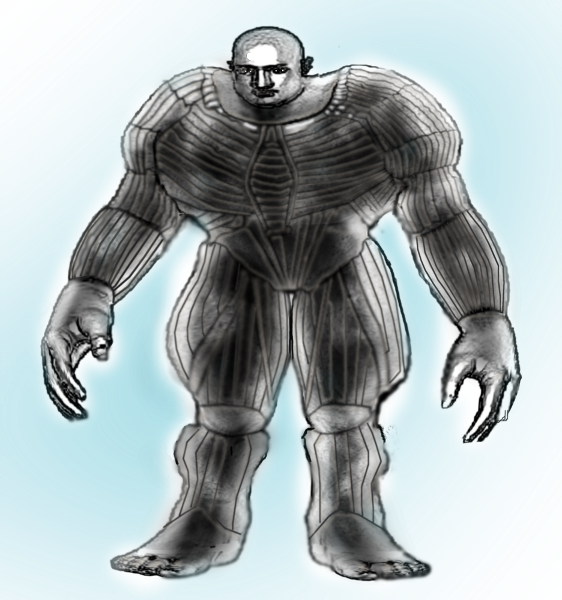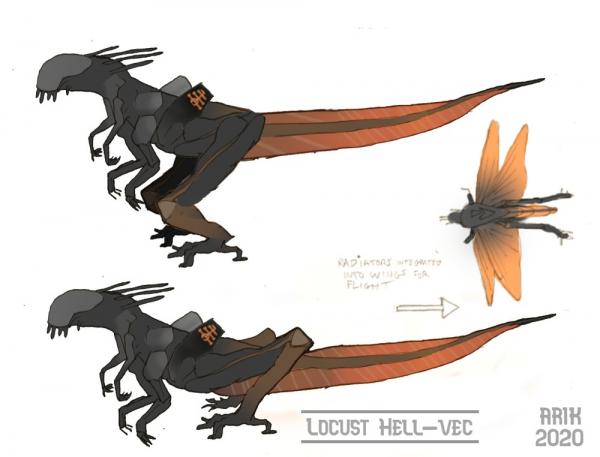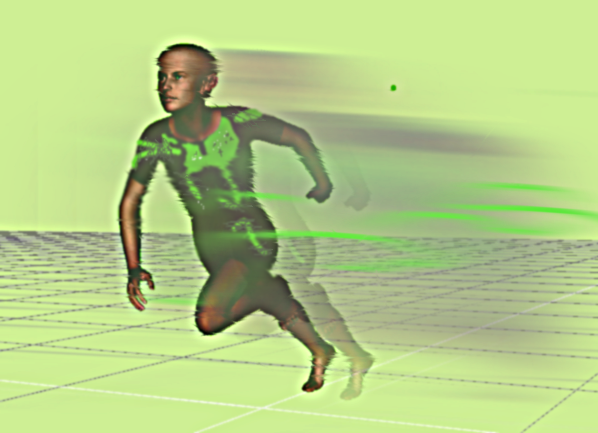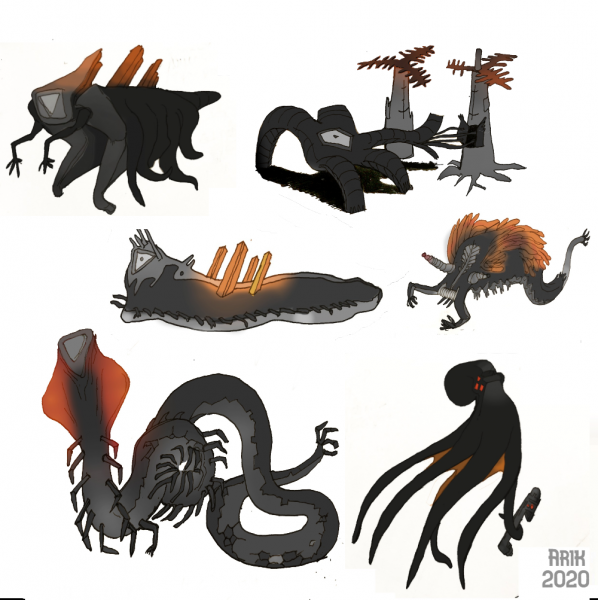BY LETTER
Ultimate Muscles
Technology > Application > Augmentics
Technology > Application > Materials Technology
Technology > Application > Robotics
Technology > Technology Levels > Transapientech / Godtech / Clarketech
Technology > Application > Materials Technology
Technology > Application > Robotics
Technology > Technology Levels > Transapientech / Godtech / Clarketech
Ultimate muscle is an electromechanical actuating material, a form of artificial muscle, made primarily of carbon, boron, and nitrogen. In appearance it is a dull black and typically formed into threads, cables, sheets, or cylinders. The underlying technology is similar to high performance superconductive energy storage. As the muscle threads become charged they will either contract or expand, depending on the variety (some ultimate muscle types only contract under voltage, some expand, and some can do either). The high tensile strength of the superconductive threads allows for high power densities (~20Mj/kg) allowing the muscles to exert forces of approximately 10GPa. Elasticity differs by design variant but typically maximum contraction/extension is approximately 30% of relaxed length.. Since ultimate muscle can exceed the yield strength of many common structural materials, machines made from ultimate muscle can push or rip through steel, rock, concrete, and sapphiroid. High strength carbon and carbon/nitrogen/boron materials can typically resist direct pressure from ultimate muscle, but suitable concentration of force often allows these materials to be defeated.
Ultimate muscle is an example of low-ground ultratech and was first invented by the transapient known as Abreps the Engineer (then at S1). The simplicity of the design has been remarked on by many transapients, and once the trick is known, ultimate muscle can be built and designed by modosophonts. Several advanced forms of cyborg augments have varying amounts of Ultimate Muscle incorporated into their structure; in particular the cyborgs known as Supersophonts include quite significant a Ultimate Muscle content in their design.
Because Ultimate Muscles use so much power, they create a lot of waste heat. At maximum force each kilogram of muscle requires an injection of 20 megajoules of energy. Whilst the muscle fibres are superconductive energy losses between fibres and storage result in kilojoules of waste heat per kilogram with each contraction. Machines and beings utilising UM require extensive cooling systems and internal reactors to function. Without these they can only operate at full power for a matter of seconds. These cooling systems may resemble large vanes, wings or even ultra-large ears capable of extending several square metres of cooling surface, and it is advisable that any heat sensitive objects or people are kept far from the radiators as they vent. Great care has to be taken not to tear or quench ultimate muscle else all of the stored energy will release at once. UM users that are fatally damaged in this way release an intense blue-white arc flash, followed by a fireball and blast wave. As a consequence of these limitations in heat and safety, as well as the high energy requirements, modosophont use of UM is often restricted to industrial and military spaces. Transapient variants typically employ better risk management systems, and at higher levels magmatter reinforcement and radiation technologies.
Smart matter swarms of ultimate muscle have a dynamic structure, being made of linked microscale ultimate muscle fibers that can quickly reconfigure themselves to any desired shape. The muscle material of these dynamic machines can often reconfigure itself to take on load-bearing properties instead of force generating properties, allowing on-the-fly creation of ultra-strong "bones". The resulting machines or vecs often appear as amorphous blobs, but many varieties can rapidly take on any shape consistent with their mass and a density of no more than 2.7 g/cm^3.
Although the ideal shape for an Ultimate Muscle user resembles that of a slug or amorphous being, it is possible for humanoid entities to take advantage of Ultimate Muscle technology as well. The main drawback is that the muscles themselves will be significantly weaker than the optimum level due to the shape and construction of a humanoid body plan. Still, even when utilizing a limited amount of Ultimate Muscles in their bodies, humanoids can boast strength levels between 200 and 800 times that of an unaugmented baseline of average size and weight, depending on just how much Ultimate Muscle is incorporated.
 Image from Steve Bowers | |
| Supersophonts have ultrahard bones to support their Ultimate Muscles; these bones usually consist of specialised diamondoid material, or solid UM boron/carbon/nitrogen compounds of comparable strength. The bones must be very large in cross-sectional area compared to the Ultimate Muscles, since the Muscles are so strong they can easily exert forces that will break the bones, either directly or indirectly | |
Comparison with Baseline Human Muscle
Baseline human muscle can exert a maximum of about 0.4 MPa under optimal conditions. Compared to the 10GPa of Ultimate Muscle, an Ultimate Muscle user might be expected to be 25,000 times stronger than an equivalently shaped human. However, this is somewhat misleading - Ultimate Muscle can exert pressures close to the yield strength of the strongest materials (about 40 to 50 GPa). Compare this to the pressure of muscle (less than 0.4 MPa) and the tensile strength of tendon (about 50 MPa), and it can be shown that the ultimate muscle user would need disproportionately thicker tendons and bones in proportion to its muscles, even though those bones and tendons consist of the strongest physical materials (in most cases some form of diamondoid or hardened Ultimate Muscle material).A humanoid equipped with Ultimate Muscles will need ultrahard bones which are approximately two orders of magnitude larger in cross-section than the equivalent bones in a biont with organic bones and muscles, or will only require ultimate muscles that are two orders of magnitude smaller if the bones are normal sized. This means that a UM user with a human-scale ultrahard skeleton would have very small muscles, and could look like a famine victim (unless a set of biological muscles are also present). Conversely a user with larger muscles would need very thick bones, resembling those of a large dinosaur.
 Image from Arik | |
| A Brontopod - a non-humanoid Ultimate Vec variant specialised for lifting and carrying heavy loads | |
 Image from Arik | |
| A Hellvec, a specialised form of Ultimate Vec optimised for jumping and powered flight | |
Jumping
When jumping, the legs to work on the body equal to the force exerted times the distance over which the force is exerted. Since the U-muscle user would be exerting about 10,000 times the force over about the same distance, it would do 10,000 times the work. The work done by the muscles becomes kinetic energy. As the jumper's body rises, the kinetic energy becomes potential energy. Potential energy increases linearly with height, so since the U-muscle user can do 10,000 times as much work, it can jump 10,000 times as high. Similarly, it can also jump 10,000 times as far. This analysis neglects aerodynamic drag, which would significantly reduce this distance. Since very athletic bionts can jump several meters high, a U-muscle user should be able to reach altitudes of tens of kilometres in vacuum under one standard earth gravity. The increased mass of a body equipped with Ultimate Muscles and ultrahard bones will reduce the jump height still further, to less than a kilometer in most cases. U-muscle users that have highly specialised bodyplans, often resembling an aerodynamic frog or flea, can improve on this height considerably.Running
If a sophont attempts to run very fast, the limitations of gravity start to become apparent. The runner's legs may move very fast, but gravity is too slow to pull the feet back into contact with the ground. As anyone who has attempted to run on a low gravity world can attest, the fastest method of locomotion where the acceleration due to gravity is weak is a series of lopes or bunny hops; this also applies to a fast moving sophont using Ultimate Muscles, and this form of locomotion can be considered as a series of low jumps. Image from Steve Bowers | |
| Hyperborgs are relatively slow compared to specialised running clades with non-humanoid bodyplans. | |
Because Ultimate Muscles use so much power, they create a lot of waste heat; without very efficient cooling systems, an Ultimate Muscle user can only operate at full power for about 6 seconds. These cooling systems may resemble large vanes, wings or even ultra-large ears capable of extending several square metres of cooling surface. The diverse group of clades known as Ultimate Vecs are optimised for the best use of Ultimate Muscle technology, and often resemble slugs or other molluscs.
Related Articles
Appears in Topics
Development Notes
Text by Ryan B (Rynn) updated 10/5/20
Adapted from the original article by Luke Campbell with additions by Steve Bowers and Omega Tyrant
Initially published on 08 September 2010.
Adapted from the original article by Luke Campbell with additions by Steve Bowers and Omega Tyrant
Initially published on 08 September 2010.







